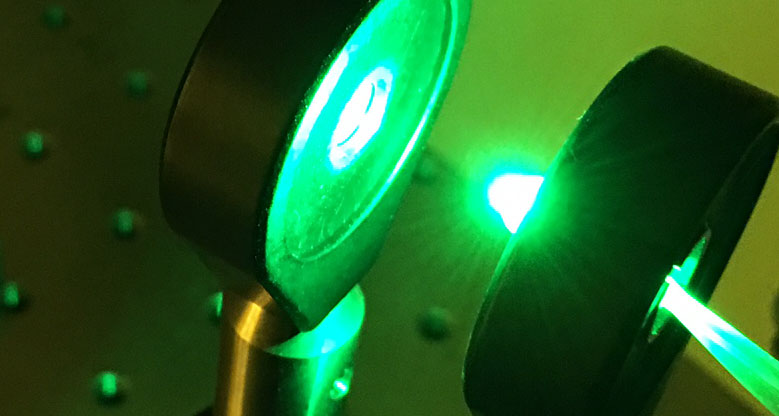Brillouin scattering spectroscopy places exacting demands on the excitation laser, with wavelength selection, stability, spectral purity, and amplitude consistency directly impacting measurement quality. Choosing the right wavelength can reduce phototoxicity or enhance scattering strength, while precise control over linewidth and drift ensures accurate resolution of the Brillouin shift. Maintaining high mode purity, often aided by mode cleaner etalons and optical isolators, further suppresses noise and improves data quality. The following sections outline key laser parameters and practical strategies for optimizing performance in Brillouin spectroscopy applications.
Wavelength
Longer wavelengths have reduced phototoxicity and are less likely to excite fluorescence; shorter wavelengths generate stronger Brillouin scattering due to 1/λ4 dependence.
Wavelength stability and linewidth
Brillouin scattering typically results in wavelength shifts from the excitation laser ranging from 3-20 GHz. Consequently, the linewidth of the laser should be less than 5 MHz. Wavelength drift over time intervals greater than seconds should be less than 50 MHz to avoid apparent broadening of the Brillouin scattered signal, and potentially to aid with supplementary mode control devices.
Laser mode purity
The excitation laser should be single longitudinal mode. Side modes are often specified as being 50 or 60 dB below the intensity of the primary longitudinal mode; this is also referred to as spectral purity. Since Brillouin signals are often 60-70 dB weaker than the excitation laser, higher mode purity is highly advantageous. Even with a very high spectral purity laser, additional optics may be required to optimize the performance of a Brillouin scattering spectroscopy system.
Adding a “mode cleaner” etalon after the laser, but before the Brillouin scattering, can further improve the spectral purity by suppressing either adjacent cavity modes or low-level amplified spontaneous emission (ASE) from the laser. The laser output can become unstable due to mode competition, which occurs when a slight temperature change causes a transient buildup of side modes. This is particularly common if the laser drifts near a mode boundary during the experiment. Therefore, a tilt-tuned, thermally stabilized Fabry-Perot etalon is highly effective for filtering out intracavity mode dynamics or sideband gain fluctuations.
Depending on the stability of the laser, adding an optical isolator after the laser is highly recommended to prevent scattered light from causing the laser to hop between longitudinal modes and introduce unwanted signals or noise floors. With or without an optical isolator, minimizing back reflections from the Brillouin system will help maintain laser stability. Tilting optics, keeping optical surfaces clean, using APC fibers, and antireflection coated fibers at fiber/air interfaces will all help to minimize back reflections.
Amplitude stability
Laser amplitude stability, defined as the consistency of output laser power over time, is essential for most applications, particularly for sensitive measurements such as Brillouin spectroscopy. It is important to note that while highly beneficial, the use of a mode cleaner etalon may appear to diminish laser amplitude stability. This is because, in a multi-mode laser, the combined power of all modes can average to a more stable output. However, when a single mode is isolated by the mode cleaner etalon, the individual power stability of that specific mode may exhibit greater fluctuations. By averaging experimental results or acquiring data over longer timescales, any potential amplitude instability effects can be mitigated while still benefiting from the improved laser purity provided by the mode cleaner etalon.
Measuring laser spectral purity
A hyperfine spectrometer offers a straightforward method for assessing the spectral purity of the excitation laser through its integrated SpectraLoK software. By analyzing images of the spectrometer output signals, the software enables characterization of a mode cleaner etalon's enhanced performance, evaluation of laser stability, and verification of an isolator's efficacy when examining the laser in isolation.
Our Brillouin spectrometers are built at a variety of wavelengths: 457 nm, 532 nm, 660 nm, and 780 nm. (Older models were also built at wavelengths including 355 nm, 385 nm, and 515 nm). Additional details and data sheets can be found on our website.
Mode cleaner etalon modules compatible with our spectrometers:
- HF-16074-457: Laser Cleanup and Fiber Coupling Module for 457nm lasers
- HF-16074-532: Laser Cleanup and Fiber Coupling Module for 532nm lasers
- HF-16074-660: Laser Cleanup and Fiber Coupling Module for 660nm lasers
Temperature control mount compatible with mode cleaner etalons: OP-13358.






